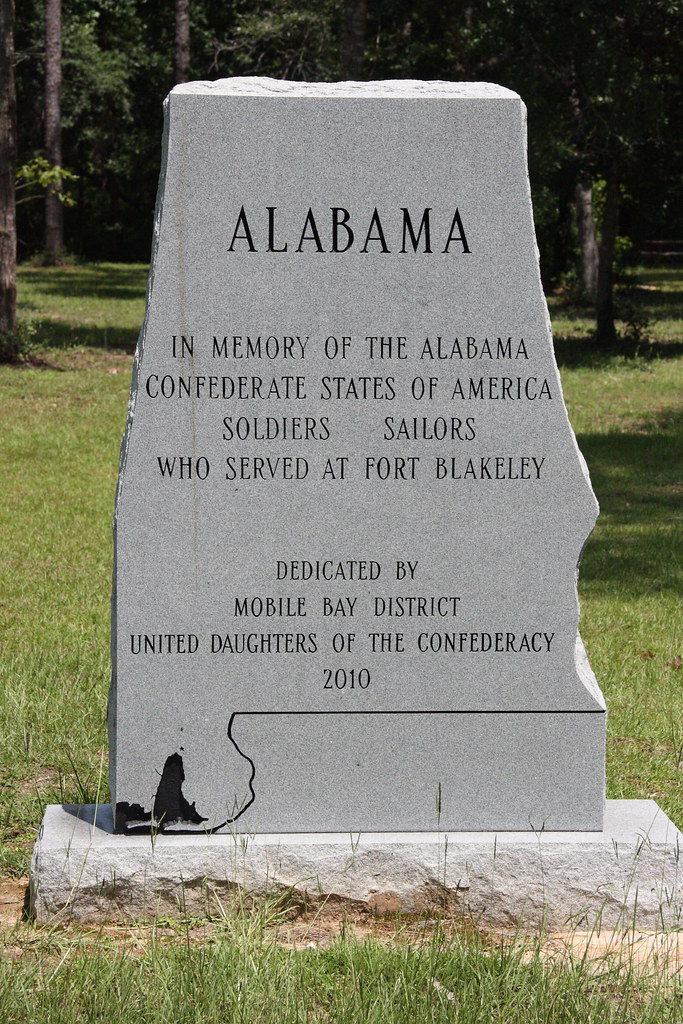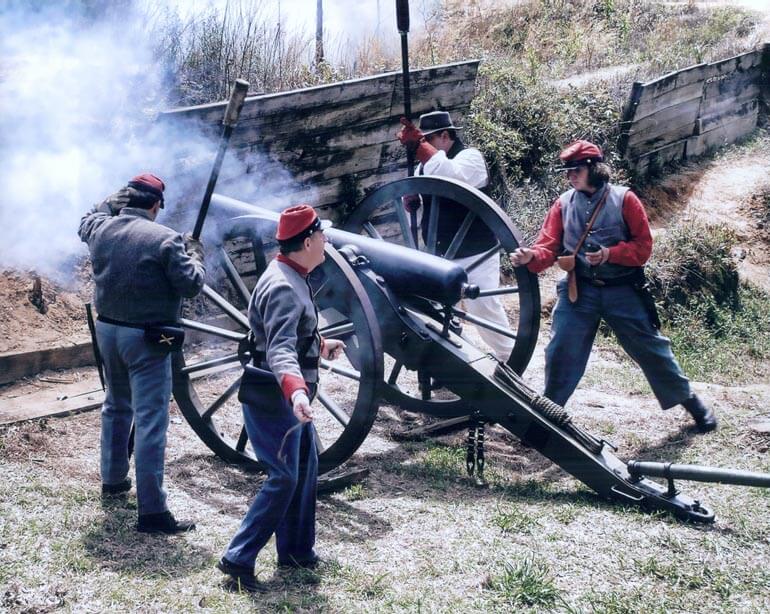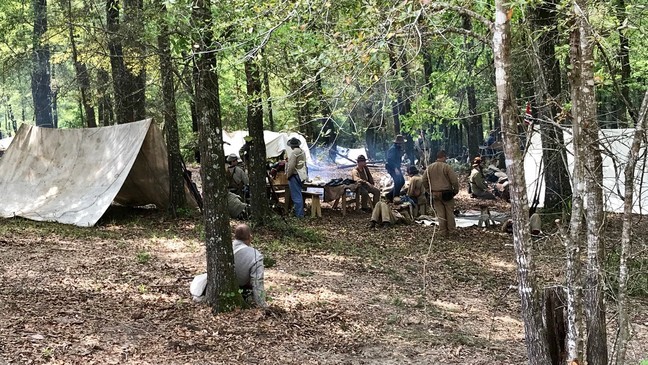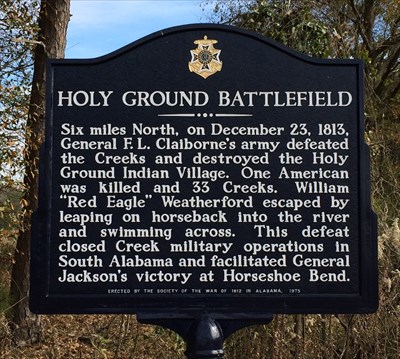The Battle of Fort Blakeley Was the Last Major Battle of The Civil War
The Battle of Fort Blakeley was considered by all military experts to be the climax of the Civil War, as this bloody brother against brother fight finally came to an end.
The day that it was fought on and the week that followed it would go down as perhaps the most important seven days in the history of the country.
This famous battle was fought on April 9, 1865, the exact same day that the Confederate Commander surrendered his army to the Union.
 Alabama Monument To The Battle of Fort Blakeley
Alabama Monument To The Battle of Fort BlakeleyHowever, because of the fierceness of the historic battle, neither the Union army, nor the Confederate army knew this.
After this historic battle things got even more interesting as only 3 days later on April 12, the last Confederate stronghold, Mobile, was also captured.
However, history was still not through with the bloody war, as 3 days after Mobile fell, April 15, President Lincoln was assassinated.
The site of this battle is preserved by the Historic Blakeley State Park, which put aside over 67 acres of the battlefield for history to remember.
The History of the Battle of Fort Blakeley
 Reenactment of the Battle of Fort Blakeley In Alabama
Reenactment of the Battle of Fort Blakeley In AlabamaThe History of the Battle of Fort Blakeley all centers on the strategic city of Mobile, Alabama, which was a vital point for the Confederates.
It was perhaps the key point to both the transportation in the south, as well as the supply center for it.
It was so important to the Confederate’s overall strategy, that the Union troops had targeted it in the early part of 1862.
However, there were several factors that occurred during this bloody war, which made the Union unable to attack this key Fort until 1865.
Because of this, the Confederate army was able to make Mobile Bay the most fortified area not only in the south, but in the entire country.
During the course of the Civil War, they were able to build three very strong fortifications around this key shipping port.
These fortifications included key artillery batteries, numerous rows of pilings, as well as something brand new to the war, “subterra shells”.
Subterra shells would later become known as land mines and made the defense of this fortified city much stronger.
Shortly after the Battle of Mobile Bay in August of 1864, and the capture of both Fort Morgan and Fort Gaines, the Union shifted their attention to what remained.
What remained for the Confederate’s included two major structures protecting the east side of Mobile Bay, Spanish Fort and Fort Blakeley, although they were not completely finished.
Spanish Fort was a structure that linked three earthen forts together along a series of bluffs that overlooked the strategic Blakeley River.
Located about five miles north of Spanish Fort was Fort Blakeley, which was an imposing structure.
It was made up of over three miles of entrenchment lines that were heavily anchored by nine redoubts, and over 40 pieces of artillery.
There were also two very large batteries located in the river, which also helped to fortify this Confederate stronghold.
This outpost was named after the local river community of Blakeley.
This area was considered to be very strategic, as it set on high ground located above very deep-water ports.
If any large Union military vessel were to try to attack this area, they had to pass right below this fort.
The Battle of Fort Blakeley
 Second Reenactment of the Battle of Fort Blakeley in Alabama
Second Reenactment of the Battle of Fort Blakeley in AlabamaThe Battle of Fort Blakeley was fought by the Confederate’s against overwhelming odds in several ways.
The battle would be fought after a two-week siege by the Union against the smaller Spanish Fort, after the Confederates put up a magnificent fight.
They were greatly out manned and outgunned at the Battle of Spanish Fort, and on the night of April 8, they evacuated it.
Once it was evacuated, the only post left to defend Mobile Bay against the Union was Fort Blakeley.
Once the Confederates who had vacated Spanish Fort arrived at Fort Blakeley, there were about 3,500 men there to help protect it, and Mobile Bay.
However, moving against them was a massive army of over 40,000 Union troops, of which 16,000 would be involved in this battle.
However, to add insult to injury, of the 3,500 Confederate troops were two regiments from the “Alabama Brigade”, who were reserves.
These reserves were teenagers and had very little combat experience.
The Confederate’s quickly cleared brush and trees in front of the fort so they could see clearly, and then erected two lines of abates.
Abates were trees that had sharpened ends like stakes, to help slow the attack of the Union troops.
They also quickly dug a complex series of rifle pits, where the Battle of Fort Blakeley would be fought in hand-to-hand combat in the late stages.
However, the Confederate troops had no idea of what was about to hit them or the fact that 40,000 troops were bearing down on them.
The Union troops had divided into two segments, and one column, under the Command of Major General Edward Canby, was advancing from the north where he had taken Fort Morgan.
Major General Fredrick Steele was leading the second wave, and he was coming at them from the west as he left Pensacola, Florida.
Major General Steele arrived at the Battle of Fort Blakely first and started the initial engagements.
Major General Canby arrived soon after and combined they had over 16,000 Union troops to the Confederates 3500, some of whom had seen very limited action if any.
With the Union Army were over 5,000 men from the USCT, which was the United States Colored Troops, who had an absolute hatred for the Confederates.
They were made up of former slaves that had been set free by the Union, and this Battle of Fort Blakeley had the largest number of Colored Troops in any battle of the Civil War.
The initial skirmishes lasted for more than a week, while the Union Troop’s engineers were building systems to get closer to the Fort.
The Confederates tried to slow the advancement of the Union troops by sending “fire balls’ on them, as well as calling on the Confederate Navy.
 Reenactment Of the Battle of Fort Blakeley
Reenactment Of the Battle of Fort BlakeleyThere were three Confederate ships docked in the nearby Tensaw River, the CSS Huntsville, Nashville, and Gaines.
They shelled the Union troops for several hours but had to retreat due to very heavy counter artillery fire from the Union Army.
The final assault in the Battle of Fort Blakely came in the afternoon of April 9, 1865, the same day as General Robert E Lee’s surrender, but neither side knew this.
Once this final assault started, it was only a matter of hours before the Confederates were beaten.
The Union troops lost several soldiers in the early fighting, but they outmanned and outgunned the Confederates.
Once the Confederate defense line was breached, the hand-to-hand combat started, and the Confederates stood no chance at this point.
Historians suggest that within 30 minutes after the hand-to-hand combat started, the Confederates surrendered.
There have been numerous allegations throughout the history that even after the Confederates surrendered, they were still killed.
However, this has never been proven to be true, although through the chaotic events that ensued, some shots may have been fired.
But there is absolutely no evidence that there was any type of mass-executions that occurred, as has been suggested by folklore stories.
In all, it is estimated that 75 Confederate soldiers were killed in the Battle of Fort Blakeley, and 150 Union soldiers died as well.
References
https://www.battlefields.org/learn/civil-war/battles/fort-blakeley
The Military History Of Alabama

Alabama Gift Store
Numerous Items for You and Your Family to Enjoy
See it here at the Gift Store
Copyright 2019-2023 Alabamabackroads.com
All Rights Reserved


















